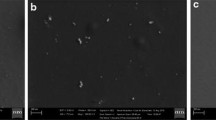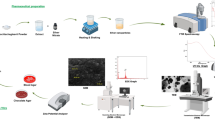Abstract
Antimicrobial citrate-stabilized silver nanoparticles (AgNPs) were synthesized by dissolving silver nitrate in water and the antimicrobial activity was studied against multidrug-resistant bacterial isolates from urine samples of diabetic patients and infected human soft tissues of patients undergoing prolonged antibiotic treatment. The minimum inhibitory concentration and minimum bactericidal concentration values of the AgNPs were found to be 60, 80 and 140, 160 μg/mL against Bacillus megaterium and Staphyloccus aureus, respectively, isolated from infected human soft tissues and 60, 80 and 120, 160 μg/mL against Kluyvera ascorbata and Escherichia coli, respectively, isolated from urine samples of diabetic patients. The sizes of the AgNPs were found to be of 141 nm and were stable till 120 days at 37 °C. The AgNPs were found to be effective against both gram-positive and negative bacterial isolates.






Similar content being viewed by others
References
Marcato, P. D., De Souza G. I. H., Alves, O. L., Esposito, E., Durán, N. (2005). Antibacterial activity of silver nanoparticles synthesized by Fusarium oxysporum strain, 4th Mercosur Congress on Process Systems Engineering, Village Rio das Pedras, Club Med, Rio de Janeiro.
Birla, S. S., Tiwari, V. V., Gade, A. K., Ingle, A. P., Yadav, A. P., & Rai, M. K. (2009). Fabrication of silver nanoparticles by Phoma glomerata and its combined effect against Escherichia coli, Pseudomonas aeruginosa and Staphylococcus aureus. Letters in Applied Microbiology, 48, 173–179.
Gong, P., Li, H., He, X., Wang, K., Hu, J., Tan, W., Tan, S., & Zhang, X. Y. (2007). Preparation and antibacterial activity of Fe3O4@Ag nanoparticles. Nanotechnology, 18, 604–611.
Feng, Q. L., Wu, J., Chen, G. Q., Cui, F. Z., Kim, T. N., & Kim, J. O. (2000). Mechanistic study of the antibacterial effect of silver ions on Escherichia coli and Staphylococcus aureus. Journal of Biomedical Materials Research, 52, 662–668.
Geethalakshmi, R., & Sarada, D. V. L. (2010). Synthesis of plant-mediated silver nanoparticles using Trianthema decandra extract and evaluation of their anti microbial activities. International Journal of Engineering, Science and Technology, 2, 970–975.
Catauro, M., Raucci, M. G., De Gaetano, F. D., & Marotta, A. (2004). Antibacterial and bioactive silver containing Na2O X CaO X 2SiO2 glass prepared by sol–gel method. Journal of Materials Science. Materials in Medicine, 15(7), 831–837.
Kim, J. S., Kuk, E., Yu, K. N., Kim, J. H., Park, S. J., Lee, H. J., Jeong, D. H., & Cho, M. H. (2007). Antimicrobial effects of silver nanoparticles. Nanomedicine Nanotechnology Biology Medicine, 3, 95–101.
Ansari, M. A., Khan, H. M., Khan, A. A., Malik, A., Sultan, A., Shahid, M., Shujatullah, F., & Azam, A. (2011). Evaluation of antibacterial activity of silver nanoparticles against MSSA and MRSA on isolates from skin infections. Biology and Medicine, 3(2), 141–146.
Vos, D. P. (2009). Bergey’s manual of systematic bacteriology (4th ed.). Dordrecht: Springer.
Kittler, S., Greulich, C., Diendorf, J., Koller, M., & Epple, M. (2010). Toxicity of silver nanoparticles increases during storage because of slow dissolution under release of silver ions. Chemistry of Materials, 22, 4548–4554.
Duran, N., Marcarto, P. D., De Souza, G. I. H., Alves, O. L., & Esposito, E. (2007). Antibacterial effect of silver nanoparticles produced by fungal process on textile fabrics and their effluent treatment. Journal of Biomedical Nanotechnology, 3, 203–208.
Ruparelia, J. P., Chatterjee, A. K., Duttagupta, S. P., Mukherji, S. (2006). Strain specificity in antimicrobial activity of silver and copper nanoparticles. A comparative study on disinfection potential of nanosilver and nanonickel, 9th Annual Conference of the Indian Environmental Association (Envirovision-2006), entitled “Advances in Environmental Management and Technology” (pp. 707–716), Goa, India.
Qi, L., Xu, Z., Jiang, X., Hu, C., & Zou, X. (2004). Preparation of antibacterial activity of chitosan nanoparticles. Carbohydrate Research, 339(2), 693–700.
Avadi, M. R., Sadeghi, A. M. N., Tahzibi, A., Bayati, K., Pouladzadeh, M., & Zohuriaan-Mehr, M. J. (2004). Diethylmethyl chitosan as an antimicrobial agent: synthesis, characterization and antibacterial effects. European Polymer Journal, 40, 1355–1361.
Guzmán, G. M., Dille, J., & Godet, S. (2008). Synthesis of silver nanoparticles by chemical reduction method and their antibacterial activity. World Academy of Science, Engineering and Technology, 43, 357–364.
Jones, S. A., Bowler, P. G., Walker, M., & Parsons, D. (2004). Controlling woung bioburden with a novel silver-containing hydrofiber dressing. Wound Repair and Regeneration, 12(3), 288–294.
Silver, S., & Phung, I. T. (1996). Bacterial heavy metal resistance: new surprises. Annual Review of Microbiology, 50, 753–789.
Ingle, A., Gade, A., Pierrat, S., Sonnichsen, C., & Rai, M. (2008). Mycosynthesis of silver nanoparticles using the fungus Fusarium acuminatum and its activity against some human pathogenic bacteria. Current Nanoscience, 4, 141–144.
Morones, J. R., Elechiguerra, J. L., Camacho, G., & Ramirez, J. T. (2005). The bactericidal effect of silver nanoparticles. Nanotechnology, 16, 2346–2353.
Pal, S., Tak, Y. K., & Song, J. M. (2007). Does the antibacterial activity of silver nanoparticles depend on the shape of the nanoparticle? A study of the gram-negative bacterium Escherichia coli. Applied Environmental Microbiololy, 27, 1712–1717.
Sondi, I., & Sondi, B. S. (2004). Silver nanoparticles as antimicrobial agent: a case study on E. coli as a model for Gram-negative bacteria. Journal of Colloid and Interface Science, 275, 177–182.
Conflict of Interest
The authors declare that they have no conflict of interest and do not have any financial relationship with the organization that sponsored the research in the manuscript.
Author information
Authors and Affiliations
Corresponding author
Rights and permissions
About this article
Cite this article
Borah, D., Buragohain, P., Saikia, A. et al. Synthesis and Evaluation of Antimicrobial Silver Nanoparticles on Multidrug-Resistant Bacterial Isolates from Urine Samples of Diabetic Patients and Infected Human Soft Tissues. BioNanoSci. 2, 322–328 (2012). https://doi.org/10.1007/s12668-012-0053-6
Published:
Issue Date:
DOI: https://doi.org/10.1007/s12668-012-0053-6




